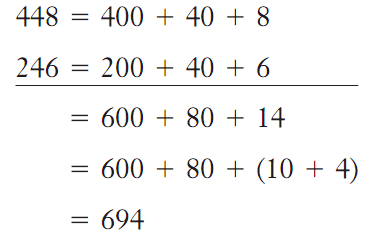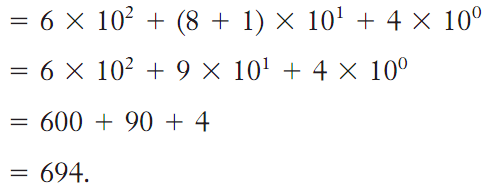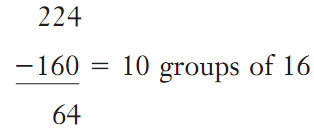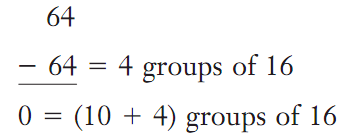
Algorithms for Arithmetic
 المؤلف:
Devine, Donald F., Judith Olsen, and Melfried Olsen
المؤلف:
Devine, Donald F., Judith Olsen, and Melfried Olsen
 المصدر:
Elementary Mathematics for Teachers, 2nd ed
المصدر:
Elementary Mathematics for Teachers, 2nd ed
 الجزء والصفحة:
...
الجزء والصفحة:
...
 1-1-2016
1-1-2016
 2757
2757
An algorithm is a sequence of steps or instructions that outline how to solve a particular problem. One can think of an algorithm as a problem-solving formula or recipe. The term “algorithm” derives its name from alKhwarizmi (c. 780–c. 850), an Arab mathematician who wrote an influential book on algebraic methods.
In the Hindu-Arabic number system, often referred to as the Arabic system, ten numerals or digits (0, 1, 2, 3, 4, 5, 6, 7, 8, 9) are used in a sequence to form a number. Each digit, when the number is written in expanded form, represents a multiple of a power of ten; for example, 247 = 2 x 102+ 4 x 101 + 2 x 100 . Therefore, this number system is called a base -10, or decimal, number system.
An algorithm that uses ten to an integer power n, 10n , to perform calculations is a base-10 algorithm. Many of the rules that are used in fundamental arithmetic are actually algorithms for the base-10 system.
The base-10 number system is used every day and may seem ordinary, but it is a very powerful and elegant system with which to express numbers.
Although most people may not be aware of it, when adding and subtracting numbers, for example, one is essentially using shortcut rules that are based on base-10 algorithms.
Addition Algorithms
Consider 448 + 246.

The base-10 algorithm for the same problem is shown explicitly below.

But

The 10 here is responsible for the 1 “carry-over” to 8, the first digit on the left. Therefore,

Subtraction Algorithms
A base-10 algorithm for solving the subtraction problem 764 - 347 follows.

Here the idea is to subtract corresponding numbers: 7 from 4, 40 from 60, and 300 from 700. It is known that 7 is greater than 4, and 7 from 4 is -3, but suppose nothing is known about negative numbers. In the first parentheses, write 60 as 50 + 10.
764- 347 = (700+ 50 + 10 + 4) - (300 + 40 + 7)
In the first parenthesis, add 10 to 4, so 14 is greater than 7.

So now the resulting problem is to subtract 7 from 14, 40 from 50, and 300 from 700.

Another algorithm for subtraction is called “subtraction by taking complements.” Consider 764 - 347 again. Adding the same number, c, to both the terms will not affect the answer, because c + (-c) = 0. So effectively the value does not change.
764 - 347 = (764 + c) - (347+ c)
Choose c so that 347+ c becomes a multiple of 10, say 1,000. Therefore, c = 653.

Multiplication Algorithms
The following presents a multiplication algorithm in a vertical and horizontal format. Consider 24 x 12. To understand this, write 24 as 20 + 4, and 12 as 10 + 2.

Using the distributive property of multiplication over addition, one can write

A Division Algorithm
Consider the division of a decimal number by another decimal number; for example, 28.75026 divided by 21.685. By using a division algorithm, this problem can be solved in three steps. The first step is to multiply the divisor by a power of ten that makes the divisor a whole number. Multiplying by 10 moves the decimal point one place to the right. Therefore, the divisor should be multiplied by 1,000, or 103 , because there are three digits to the right of the decimal point in the divisor.
The second step is to multiply the numerator by 103 . This is a necessary step to keep the division answer unchanged because multiplying both the dividend and the divisor by the same number keeps the fraction unchanged. Therefore, the decimal point in the dividend is moved three places to the right.
The resulting problem is to divide 28,750.26 by 21,685. The third step is to proceed with long division to get the answer.
Consider the following problem. There are 224 bananas. Each crate is packed with 16 bananas. How many crates are needed to pack all the bananas? Find the number that results from dividing 224 by 16. In other words, how many groups of 16 bananas are there in 224 total bananas?
In the first step of the division algorithm for 224/16, find the number of bananas that would be packed in the first ten crates and subtract it from the total bananas.

The next step is to figure out how many groups of 16 consist of 64.

Therefore, 224/16 - 14. In fact, all arithmetic calculations are based on base-10 algorithms. SEE ALSO Bases; Decimals; Powers and Exponents.
____________________________________________________________________________________________
Reference
Devine, Donald F., Judith Olsen, and Melfried Olsen. Elementary Mathematics for Teachers, 2nd ed. New York: John Wiley, 1991.
Dugopolski, Mark. Elementary Algebra, 2nd ed. New York: Addison-Wesley Publishing Company, 1996.
Miller, Charles D., Vern E. Heeren, and E. John Hornsby, Jr. Mathematical Ideas, 9th ed. Boston: Addison-Wesley, 2001.
Young, Robyn V., ed. Notable Mathematicians, from Ancient Times to the Present. Detroit: Gale Research, 1998.
 الاكثر قراءة في الرياضيات العامة
الاكثر قراءة في الرياضيات العامة
 اخر الاخبار
اخر الاخبار
اخبار العتبة العباسية المقدسة


